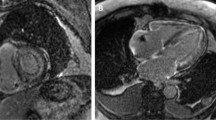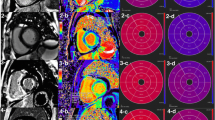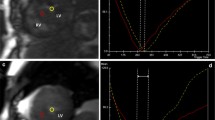Abstract
Objectives
Using cardiac magnetic resonance imaging (MRI) we tested the diagnostic value of various markers for amyloid infiltration.
Methods
We performed MRI at 1.5 T in 36 consecutive patients with cardiac amyloidosis and 48 healthy volunteers. The protocol included cine imaging, T2-weighted spin echo, T1-weighted spin echo before and early after contrast and late gadolinium enhancement. We compared the frequency of abnormalities and their relation to mortality.
Results
Median follow-up was 31 months. Twenty-three patients died. Mean left ventricular (LV) mass was 205 ± 70 g. LV ejection fraction (EF) was 55 ± 12%. T2 ratio was 1.5 ± 0.4. 33/36 patients had pericardial and 22/36 had pleural effusions. All but two had heterogeneous late enhancement. Surviving patients did not differ from those who had died with regard to gender, LV mass or volume. Surviving patients had a significantly higher LVEF (60.4 ± 9.9% vs. 51.6 ± 11.5%; p = 0.03). The deceased patients had a lower T2 ratio than those who survived (1.38 ± 0.42 vs. 1.76 ± 0.17; p = 0.005). Low T2 was associated with shorter survival (Chi-squared 11.3; p < 0.001). Cox regression analysis confirmed T2 ratio < 1.5 as the only independent predictors for survival.
Conclusion
Cardiac amyloidosis is associated with hypointense signal on T2-weighted images. A lower T2 ratio was independently associated with shortened survival.






Similar content being viewed by others
References
Falk RH (2005) Diagnosis and management of the cardiac amyloidoses. Circulation 112:2047–2060
Selvanayagam JB, Hawkins PN, Paul B, Myerson SG, Neubauer S (2007) Evaluation and management of the cardiac amyloidosis. J Am Coll Cardiol 50:2101–2110
Roberts WC, Waller BF (1983) Cardiac amyloidosis causing cardiac dysfunction: analysis of 54 necropsy patients. Am J Cardiol 52:137–146
Rahman JE, Helou EF, Gelzer-Bell R et al (2004) Noninvasive diagnosis of biopsy-proven cardiac amyloidosis. J Am Coll Cardiol 43:410–415
Eriksson P, Backman C, Eriksson A, Eriksson S, Karp K, Olofsson BO (1987) Differentiation of cardiac amyloidosis and hypertrophic cardiomyopathy. A comparison of familial amyloidosis with polyneuropathy and hypertrophic cardiomyopathy by electrocardiography and echocardiography. Acta Med Scand 221:39–46
Murtagh B, Hammill SC, Gertz MA, Kyle RA, Tajik AJ, Grogan M (2005) Electrocardiographic findings in primary systemic amyloidosis and biopsy-proven cardiac involvement. Am J Cardiol 95:535–537
Kristen AV, Meyer FJ, Perz JB et al (2005) Risk stratification in cardiac amyloidosis: Novel approaches. Transplantation 80:S151–S155
Nordlinger M, Magnani B, Skinner M, Falk RH (2005) Is elevated plasma b-natriuretic peptide in amyloidosis simply a function of the presence of heart failure? Am J Cardiol 96:982–984
Dispenzieri A, Gertz MA, Kyle RA et al (2004) Serum cardiac troponins and n-terminal pro-brain natriuretic peptide: a staging system for primary systemic amyloidosis. J Clin Oncol 22:3751–3757
Kim RJ, Shah DJ, Judd RM (2003) How we perform delayed enhancement imaging. J Cardiovasc Magn Reson 5:505–514
Choudhury L, Mahrholdt H, Wagner A et al (2002) Myocardial scarring in asymptomatic or mildly symptomatic patients with hypertrophic cardiomyopathy. J Am Coll Cardiol 40:2156–2164
Moon JC, Reed E, Sheppard MN et al (2004) The histologic basis of late gadolinium enhancement cardiovascular magnetic resonance in hypertrophic cardiomyopathy. J Am Coll Cardiol 43:2260–2264
Hunold P, Schlosser T, Vogt FM et al (2005) Myocardial late enhancement in contrast-enhanced cardiac MRI: Distinction between infarction scar and non-infarction-related disease. Am J Roentgenol 184:1420–1426
Lim RP, Srichai MB, Lee VS (2007) Non-ischemic causes of delayed myocardial hyperenhancement on MRI. Am J Roentgenol 188:1675–1681
Bohl S, Wassmuth R, Abdel-Aty H et al (2008) Delayed enhancement cardiac magnetic resonance imaging reveals typical patterns of myocardial injury in patients with various forms of non-ischemic heart disease. Int J Cardiovasc Imaging 24:597–607
Maceira AM, Joshi J, Prasad SK et al (2005) Cardiovascular magnetic resonance in cardiac amyloidosis. Circulation 111:186–193
Perugini E, Rapezzi C, Piva T et al (2006) Noninvasive evaluation of the myocardial substrate of cardiac amyloidosis by gadolinium cardiac magnetic resonance. Heart 92(3):343–349
Vogelsberg H, Mahrholdt H, Deluigi CC et al (2008) Cardiovascular magnetic resonance in clinically suspected cardiac amyloidosis: Noninvasive imaging compared to endomyocardial biopsy. J Am Coll Cardiol 51:1022–1030
Seeger A, Klumpp B, Kramer U et al (2009) MRI assessment of cardiac amyloidosis: experience of six cases with review of the current literature. Br J Radiol 82:337–342
Abdel-Aty H, Boye P, Zagrosek A et al (2005) Diagnostic performance of cardiovascular magnetic resonance in patients with suspected acute myocarditis: comparison of different approaches. J Am Coll Cardiol 45:1815–1822
Friedrich MG, Strohm O, Schulz-Menger J, Marciniak H, Luft FC, Dietz R (1998) Contrast media-enhanced magnetic resonance imaging visualizes myocardial changes in the course of viral myocarditis. Circulation 97:1802–1809
Anderson JL, Horne BD, Pennell DJ (2005) Atrial dimensions in health and left ventricular disease using cardiovascular magnetic resonance. J Cardiovasc Magn Reson 7:671–675
Maceira AM, Prasad SK, Khan M, Pennell DJ (2006) Normalized left ventricular systolic and diastolic function by steady state free precession cardiovascular magnetic resonance. J Cardiovasc Magn Reson 8:417–426
Gean-Marton AD, Kirsch CF, Vezina LG, Weber AL (1991) Focal amyloidosis of the head and neck: evaluation with CT and MR imaging. Radiology 181:521–525
Celletti F, Fattori R, Napoli G et al (1999) Assessment of restrictive cardiomyopathy of amyloid or idiopathic etiology by magnetic resonance imaging. Am J Cardiol 83(798–801):a10
Barnes ME, Miyasaka Y, Seward JB et al (2004) Left atrial volume in the prediction of first ischemic stroke in an elderly cohort without atrial fibrillation. Mayo Clin Proc 79:1008–1014
Fattori R, Rocchi G, Celletti F, Bertaccini P, Rapezzi C, Gavelli G (1998) Contribution of magnetic resonance imaging in the differential diagnosis of cardiac amyloidosis and symmetric hypertrophic cardiomyopathy. Am Heart J 136:824–830
Berk JL (2005) Pleural effusions in systemic amyloidosis. Curr Opin Pulm Med 11:324–328
Asaumi J, Yanagi Y, Hisatomi M, Konouchi H, Kishi K (2001) CT and MR imaging of localized amyloidosis. Eur J Radiol 39:83–87
Sueyoshi E, Sakamoto I, Okimoto T, Hayashi K, Tanaka K, Toda G (2006) Cardiac amyloidosis: typical imaging findings and diffuse myocardial damage demonstrated by delayed contrast-enhanced MRI. Cardiovasc Intervent Radiol 29:710–712
vanden Driesen RI, Slaughter RE, Strugnell WE (2006) MR findings in cardiac amyloidosis. AJR Am J Roentgenol 186:1682–1685
Bucciarelli-Ducci C, Locca D, Barbeau G, Prasad SK (2007) Value of cardiovascular magnetic resonance for determining cardiac involvement in systemic amyloidosis. Eur Heart J 28:1186
Syed IS, Glockner JF, Feng D et al (2010) Role of cardiac magnetic resonance imaging in the detection of cardiac amyloidosis. JACC Cardiovasc Imaging 3:155–164
Leeson CP, Myerson SG, Walls GB, Neubauer S, Ormerod OJ (2006) Atrial pathology in cardiac amyloidosis: evidence from ECG and cardiovascular magnetic resonance. Eur Heart J 27:1670
Van Geluwe F, Dymarkowski S, Crevits I, De Wever W, Bogaert J (2006) Amyloidosis of the heart and respiratory system. Eur Radiol 16:2358–2365
Cheng AS, Banning AP, Mitchell AR, Neubauer S, Selvanayagam JB (2006) Cardiac changes in systemic amyloidosis: visualisation by magnetic resonance imaging. Int J Cardiol 113:E21–E23
Ruberg FL, Appelbaum E, Davidoff R et al (2009) Diagnostic and prognostic utility of cardiovascular magnetic resonance imaging in light-chain cardiac amyloidosis. Am J Cardiol 103:544–549
Austin BA, Tang WH, Rodriguez ER et al (2009) Delayed hyper-enhancement magnetic resonance imaging provides incremental diagnostic and prognostic utility in suspected cardiac amyloidosis. JACC Cardiovasc Imaging 2:1369–1377
Lyne JC, Petryka J, Pennell DJ (2008) Atrial enhancement by cardiovascular magnetic resonance in cardiac amyloidosis. Eur Heart J 29:212
Gertz MA, Comenzo R, Falk RH et al (2005) Definition of organ involvement and treatment response in immunoglobulin light chain amyloidosis (al): a consensus opinion from the 10th international symposium on amyloid and amyloidosis, Tours, France, 18–22 April 2004. Am J Hematol 79:319–328
Maceira AM, Prasad SK, Hawkins PN, Roughton M, Pennell DJ (2008) Cardiovascular magnetic resonance and prognosis in cardiac amyloidosis. J Cardiovasc Magn Reson 10:54
Sparrow P, Amirabadi A, Sussman MS, Paul N, Merchant N (2009) Quantitative assessment of myocardial T2 relaxation times in cardiac amyloidosis. J Magn Reson Imaging 30:942–946
Krombach GA, Hahn C, Tomars M et al (2007) Cardiac amyloidosis: MR imaging findings and T1 quantification, comparison with control subjects. J Magn Reson Imaging 25:1283–1287
Hosch W, Bock M, Libicher M et al (2007) MR-relaxometry of myocardial tissue: significant elevation of T1 and T2 relaxation times in cardiac amyloidosis. Invest Radiol 42:636–642
Acknowledgement
We gratefully acknowledge the support of Carsten Schwenke (SCOSSiS Statistical Consulting). We sincerely thank Wilko Weichert MD, Pathology Institute, Charite, University Medicine Berlin, for providing Fig. 1. We are indebted to our technicians Denise Kleindienst, Kerstin Kretschel and Evi Polzin.
Author information
Authors and Affiliations
Corresponding author
Rights and permissions
About this article
Cite this article
Wassmuth, R., Abdel-Aty, H., Bohl, S. et al. Prognostic impact of T2-weighted CMR imaging for cardiac amyloidosis. Eur Radiol 21, 1643–1650 (2011). https://doi.org/10.1007/s00330-011-2109-3
Received:
Revised:
Accepted:
Published:
Issue Date:
DOI: https://doi.org/10.1007/s00330-011-2109-3




